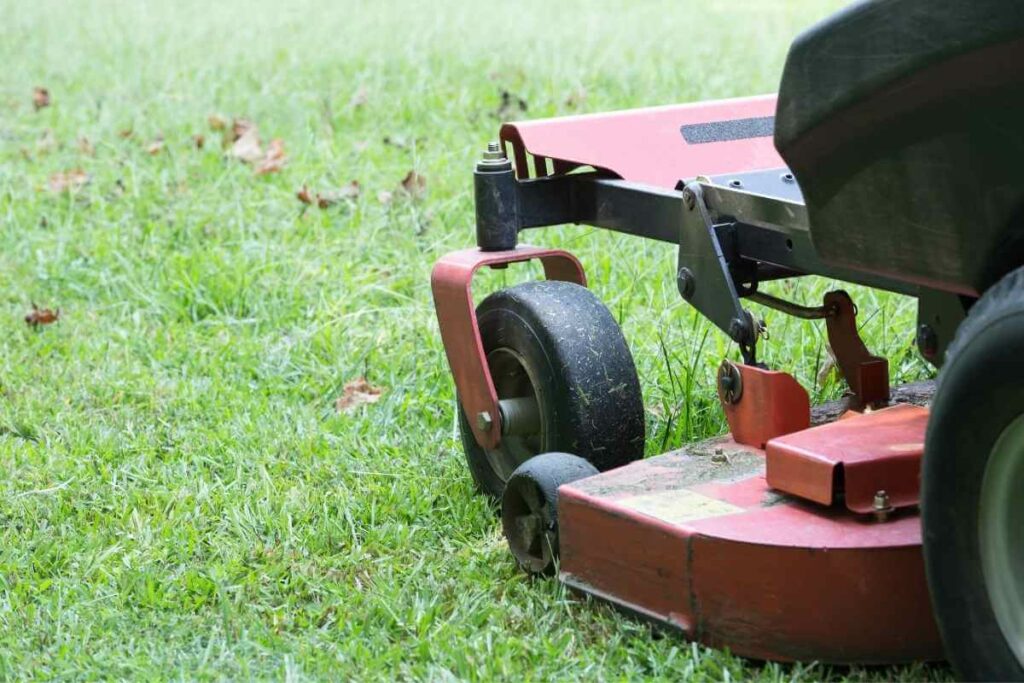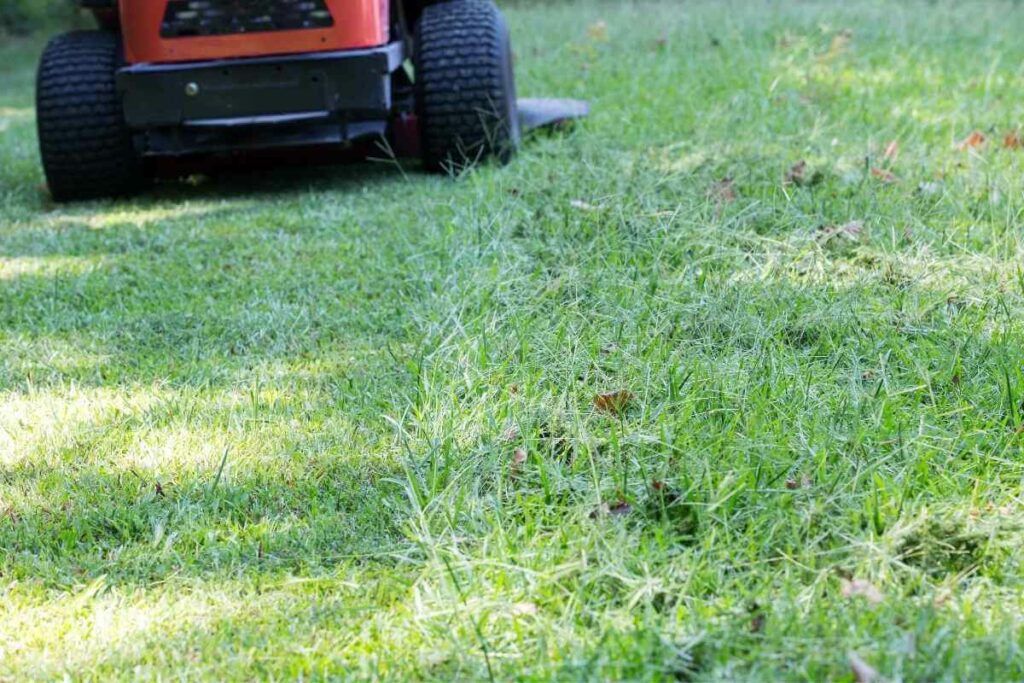While it is usually better to cut a lawn while it is dry, you still should not let your grass overgrow during the wet seasons.
Aside from the obvious safety issues such as grass becoming slippery when wet, mowing your lawn while wet may also damage your property.
Additionally, wet clippings might clog your mower, which is unsafe. Also, it may tear up the grass, spread lawn diseases and stain everything.
However, wet grass can be mowed using zero-turn mowers if the necessary safety measures are followed. Ensure that you reduce your speed, sharpen the mower blades, slow your throttle, and rounding your turns.
Risk and Tips of Mowing Wet Grass
| Risk of Mowing Wet Grass | Tips/ Solutions |
|---|---|
| Losing control of the mower could result in slips and falls. | Decelerate the zero-turn mower |
| Ripped lawns. | Sharpen mower blades before you begin mowing. Slow your throttle for gentle mowing. Moving up and down a slope. |
| Sharp turns cause divots which are irreversible even after drying. | Round your corners as possible when moving. |
| Skidding on hills. | Avoid mowing on hills with over 15 degrees incline. |
Tips for Mowing Wet Grass with a Zero Turn Mower
Slowing Down
One of the main reasons people move from an ordinary mower to a zero-turn mower is its speed.
When the weather is good, you can mow your lawn in a reasonably short period. However, if your yard is damp, you must use caution.

Trying to accelerate on wet grass can result in you losing control of the mower because the tires will not grip the wet ground well. This is precisely why dialing back the speed is a wise move to trim the grass safely and efficiently.
It is also recommended that you steer your mower in various directions. Instead of mowing in a single direction as you would with dry grass.
Consider cutting horizontally and vertically to cut the bent wet grass blades.
Mowing damp grass slowly but steadily will not only decrease the chance of slipping and falling but also save your mower from having to work too hard to cut the wet grass.
It also prevents you from tearing the grass, resulting in an uneven cut or, worse, root damage.
Sharpening Mower Blades
Mowing wet grass is tricky, and on top of that, it makes your mower work harder than usual.
Aside from that, blunt blades may also rip your grass, resulting in a fuzzy cut or, worse, irreversible lawn damage.
One of the keys to cutting damp grass is to have sharp blades. You can reduce the strain by using knives that are sharp enough to cut through the grass.
Be Careful: Sharpening your mower blades is simple, and you can learn how to do it quickly. Make sure your blades are sharp before you begin.
Rounding Your Turns
If you’ve been around zero turn mowers for a while, you’ll know that for the best and fast cut on dry grass, you should do square turns.
In a square turn, you come to a complete stop, pivot, and turn. Any pivot action on dry grass increases the likelihood of ripping it up.
However, avoid making sharp turns if you want to achieve a good cut on damp grass with your zero-turn.
Making these sharp turns might cause tiny divots to form on your wet grass.
Even after the grass has dried, these markings will remain visible.
When the grass is wet, round your corners as possible; they may not look as good as they usually do, but round turns are preferable since they decrease the chance of ripping up the yard.
Slowing Your Throttle
Slow down the engine throttle to cut wet grass as gently as possible.
Pulling back on the engine throttle not only slows down your zero-turn mower but also slows down the blade tips.
This helps more than not pushing the sticks as far forward since it makes the hydrous less sensitive, requiring you to go slower to cut the grass properly and therefore less likely to tear up your yard.
Mowing Up And Down Slope/Hill
Zero-turn mowers equipped with GT Trac are intended to take on slight inclines and hills by providing precision traction and balance.
It’s an entirely different story when you’re mowing wet slopes and inclines. Wet, soggy terrain makes navigating slopes difficult for nearly any machine.
If your landscape design includes several hills, you must be careful when mowing them when they are damp—moving up a slope stresses on your grass in soft ground, causing it to be pulled out of the bed by the blade of a zero-turn mower.
Works Best: Mowing up and down a slope relieves tension, resulting in a far more excellent cut.
Mowing On Moderate Slopes/ Avoid Mowing On High Hills
When it’s wet, it’s also a lot easier to slide down the slope, which is dangerous.

Furthermore, sharp hill turns may lead to skidding, which will result in a nasty tumble down the hill.
Because of the severe damage this can do, it is recommended that you wait it out and let the grass dry when it comes to mowing hills, especially inclines of over fifteen degrees.
But you can try it on moderate slopes.
Also, check your tires; if they are frequently underinflated, ensure that they are properly inflated before you begin cutting your dump lawn.
Attempting to drive up and down these slopes with underinflated tires may cause a slew of issues.
Final Thoughts
While there are some conditions under which it’s acceptable to run the mower after a rainstorm.
The timing is ill-advised. It’s never advisable to mow in wet conditions since it could damage the mower or the grass although, sometimes mowing a damp lawn is unavoidable.
If one really can’t wait for it to dry to mow the lawn, a few adjustments must be made to accommodate the wet conditions.
These tricks help minimize the problems during the process and maintain a tidy lawn even in soaking times.
Also Useful
- Do Green Roofs Need Drainage?
- Starting a Lawn Care Business? 50 Lawn Care Business Names
- 11 Businesses That You Could Start If You Love Gardening
